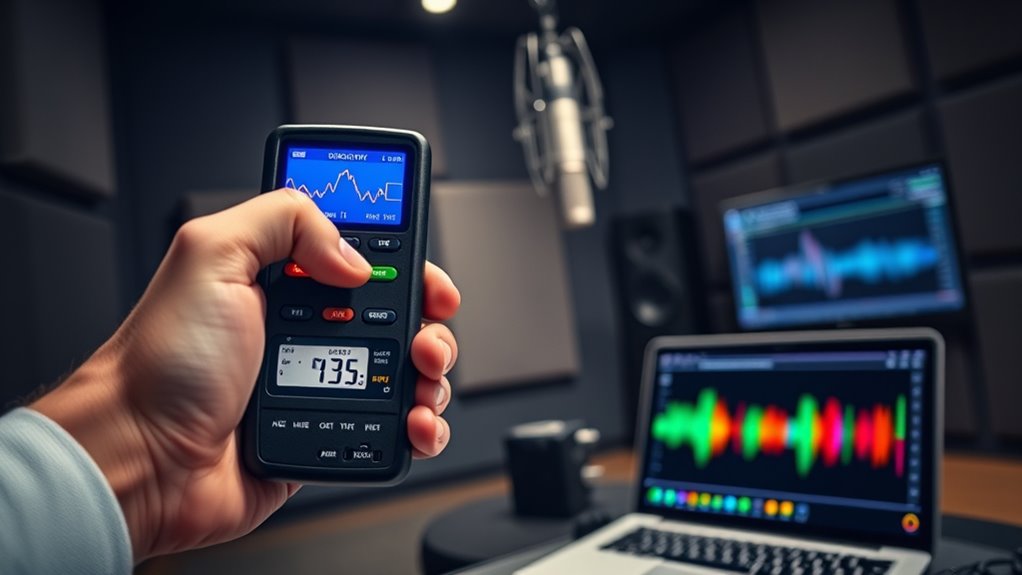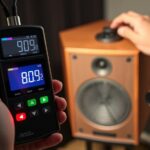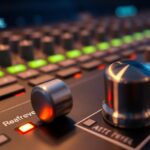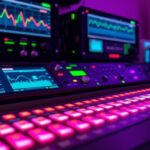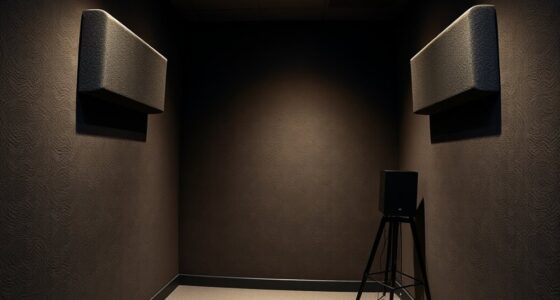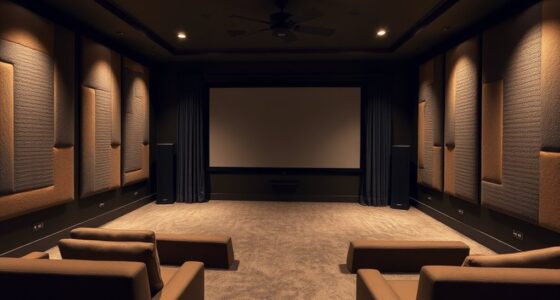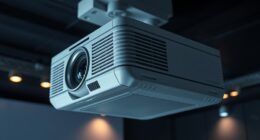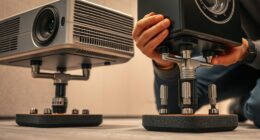To measure decibel levels for ideal audio, use a reliable sound level meter and position it correctly at ear level, avoiding your body to avoid interference. Take multiple readings to guarantee accuracy and consider environmental factors like reflections. Monitoring helps you find the right balance for clear sound without risking hearing damage. If you want to learn simple steps to improve your audio setup and protect your hearing, keep exploring further.
Key Takeaways
- Use a calibrated sound level meter to accurately measure audio decibel levels during playback.
- Position the meter at ear level and away from your body to ensure precise readings.
- Aim for a decibel range between 70-85 dB for optimal audio clarity without risking hearing damage.
- Take multiple readings at different times to assess consistent sound quality and volume levels.
- Adjust audio equipment settings based on measurements to achieve balanced, comfortable sound levels.

Have you ever wondered how loud a sound really is? Understanding the volume of noise around you isn’t just about avoiding discomfort; it’s vital for protecting your hearing. When it comes to measuring decibel levels accurately, sound level meters are your best tools. These devices allow you to gauge noise intensity precisely, which is especially important in environments where loud sounds are common, such as concerts, construction sites, or even busy offices. Using sound level meters isn’t complicated, but knowing how to interpret their readings can make a big difference in maintaining hearing safety.
Understanding decibel levels helps protect your hearing in noisy environments.
Hearing safety should always be a priority, particularly if you’re regularly exposed to loud noises. Prolonged exposure to high decibel levels can cause irreversible hearing damage, so it’s essential to monitor sound levels diligently. Sound level meters provide real-time data, helping you identify when noise exceeds safe limits. For example, noise levels above 85 decibels for extended periods can be harmful, so if your environment hits that mark, it’s time to take action. Wearing ear protection, reducing exposure time, or implementing noise control measures can help safeguard your hearing health. Regularly checking sound levels with these meters helps you stay aware of potential risks and adjust your activities accordingly.
Using sound level meters isn’t just for professionals; they’re accessible and easy to use for anyone concerned about noise levels. When measuring decibel levels, make sure to position the device correctly—away from your body and at ear level—to get accurate readings. Keep in mind that environmental factors, such as reflections or background noise, can affect measurements, so take multiple readings if necessary. By consistently monitoring noise levels, you develop an understanding of when sound becomes potentially harmful. This awareness empowers you to make smarter choices, like moving away from loud sources or wearing ear protection. Additionally, understanding projector technology features like sound output and noise levels can help you create a more comfortable home theater environment.
Ultimately, maintaining awareness of sound levels is about more than just comfort—it’s about protecting your long-term hearing health. Sound level meters are invaluable tools that allow you to quantify noise and make informed decisions. Whether you’re working in a noisy environment or enjoying music at home, keeping an eye on decibel levels can prevent hearing loss and ensure you stay within safe limits. Remember, your ears are delicate, and taking proactive steps with the help of sound level meters ensures you can enjoy sound safely for years to come.
Frequently Asked Questions
What Is the Ideal Decibel Range for Different Music Genres?
For different music genres, the ideal decibel range varies to guarantee superior sound quality. You should aim for 70-85 dB for genres like jazz and classical, which require clarity and detail. For rock or electronic music, 85-100 dB is suitable, but be cautious with sound amplification to avoid distortion or hearing damage. Use your audio equipment wisely, adjusting sound levels to maintain a balanced, rich listening experience across genres.
How Often Should I Calibrate My Decibel Meter?
Back in the day, calibration was a once-in-a-lifetime event, but now, to keep your meter accurate, you should calibrate it regularly—at least once every six months or after any rough handling. This guarantees your calibration frequency maintains meter accuracy. Regular checks prevent drift and ensure your readings stay reliable, whether you’re mixing music or setting up a sound system. Don’t wait too long to keep your audio sharp.
Can Environmental Factors Affect Decibel Readings?
Yes, environmental factors like sound reflections and temperature effects can impact your decibel readings. Sound reflections from walls or surfaces can cause echoes, making sounds seem louder or softer than they actually are. Temperature changes can also affect the accuracy of your meter, as equipment may respond differently in heat or cold. To get reliable measurements, perform calibrations regularly and consider these environmental influences during testing.
What Are Common Mistakes When Measuring Decibel Levels?
Did you know that over 30% of inaccurate decibel readings come from common mistakes? When measuring, you might forget to account for background noise, which skews results. Always use proper calibration techniques before measuring, and make certain your device is set correctly. Avoid holding the microphone too close or at inconsistent distances, as these errors can lead to unreliable data. Precision depends on careful setup and awareness of environmental factors.
How Do Decibel Levels Impact Hearing Health?
High decibel levels can cause auditory damage and noise-induced hearing loss if you’re exposed to them frequently or for long periods. When the sound exceeds safe limits, your ears suffer damage, which might lead to permanent hearing issues. To protect your hearing health, avoid loud environments, use ear protection, and keep track of decibel levels. Being mindful of loud sounds helps prevent noise-induced hearing loss and preserves your overall auditory health.
Conclusion
By regularly measuring decibel levels, you guarantee ideal audio quality and protect your hearing. For example, a live music venue that monitors decibel levels prevents damage to both performers and attendees, creating a safer environment. Remember, using a reliable sound level meter helps you stay within safe limits, whether you’re setting up a home theater or managing a concert. Staying mindful of decibel levels keeps your audio experience enjoyable and safe for everyone involved.
